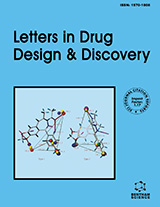Abstract
Background: Quantitative structure–activity relationship (QSAR) models could provide both statistical significance and useful chemical insights for drug design. The QSAR method has found applications for predicting diverse properties of organic compounds, including antiviral activities, toxicities and biological activities. In this work, a quantitative structure-activity relationship was utilized for the prediction of allosteric BRAF (V600E) inhibitory activities.
Methods: A data set which contains 54 molecules was classified into training and test sets. Stepwise (SW) and genetic algorithm (GA) methods were employed for feature selection. The models were validated using the cross-validation and external test set. Results: Results showed that the GA approach is a more powerful technique than SW for the selection of suitable descriptors. The squared cross-validated correlation coefficient for leave-one-out of 0.702 and squared correlation coefficient of 0.793 was obtained for the training set compounds by GA–MLR model. Conclusion: The obtained GA–MLR model could be applied as a worthwhile model for designing similar groups of the mentioned inhibitors.Keywords: QSAR, multiple linear regression, stepwise, genetic algorithm, BRAF (V600E) inhibitors, inhibitory activity.
Graphical Abstract
Current Computer-Aided Drug Design
Title:Prediction of Activities of BRAF (V600E) Inhibitors by SW-MLR and GA-MLR Methods
Volume: 13 Issue: 3
Author(s): Parinaz Pargolghasemi, Mir Saleh Hoseininezhad-Namin and Aiyoub Parchehbaf Jadid*
Affiliation:
- Department of Chemistry, Ardabil Branch Islamic Azad University, Ardabi,Iran
Keywords: QSAR, multiple linear regression, stepwise, genetic algorithm, BRAF (V600E) inhibitors, inhibitory activity.
Abstract: Background: Quantitative structure–activity relationship (QSAR) models could provide both statistical significance and useful chemical insights for drug design. The QSAR method has found applications for predicting diverse properties of organic compounds, including antiviral activities, toxicities and biological activities. In this work, a quantitative structure-activity relationship was utilized for the prediction of allosteric BRAF (V600E) inhibitory activities.
Methods: A data set which contains 54 molecules was classified into training and test sets. Stepwise (SW) and genetic algorithm (GA) methods were employed for feature selection. The models were validated using the cross-validation and external test set. Results: Results showed that the GA approach is a more powerful technique than SW for the selection of suitable descriptors. The squared cross-validated correlation coefficient for leave-one-out of 0.702 and squared correlation coefficient of 0.793 was obtained for the training set compounds by GA–MLR model. Conclusion: The obtained GA–MLR model could be applied as a worthwhile model for designing similar groups of the mentioned inhibitors.Export Options
About this article
Cite this article as:
Pargolghasemi Parinaz , Hoseininezhad-Namin Saleh Mir and Jadid Parchehbaf Aiyoub *, Prediction of Activities of BRAF (V600E) Inhibitors by SW-MLR and GA-MLR Methods, Current Computer-Aided Drug Design 2017; 13 (3) . https://dx.doi.org/10.2174/1573409913666170303113812
| DOI https://dx.doi.org/10.2174/1573409913666170303113812 |
Print ISSN 1573-4099 |
| Publisher Name Bentham Science Publisher |
Online ISSN 1875-6697 |
 34
34 5
5
- Author Guidelines
- Bentham Author Support Services (BASS)
- Graphical Abstracts
- Fabricating and Stating False Information
- Research Misconduct
- Post Publication Discussions and Corrections
- Publishing Ethics and Rectitude
- Increase Visibility of Your Article
- Archiving Policies
- Peer Review Workflow
- Order Your Article Before Print
- Promote Your Article
- Manuscript Transfer Facility
- Editorial Policies
- Allegations from Whistleblowers
Related Articles
-
Applications of 211At and 223Ra in Targeted Alpha-Particle Radiotherapy
Current Radiopharmaceuticals Synthetic Peptide Drugs for Targeting Skin Cancer: Malignant Melanoma and Melanotic Lesions
Current Medicinal Chemistry Emerging Role of Cetuximab in the Treatment of Colorectal Cancer
Recent Patents on Anti-Cancer Drug Discovery Stem Cell Transplantation in Pediatric Leukemia and Myelodysplasia: State of the Art and Current Challenges
Current Stem Cell Research & Therapy Editorial [Hot Topic :Current Advances In Therapeutic Applications of Nuclear Receptors (Guest Editor: Stefano Fiorucci)]
Current Topics in Medicinal Chemistry Development of Vitamin D Analogs Modulating the Pocket Structure of Vitamin D Receptor
Current Topics in Medicinal Chemistry Progesterone Receptor Membrane Component 1 and its Accomplice: Emerging Therapeutic Targets in Lung Cancer
Endocrine, Metabolic & Immune Disorders - Drug Targets Application of Radioisotopes in Anti-Fungal Research and Fungal Disease Studies
Current Medicinal Chemistry - Anti-Infective Agents Recent Advances in the Synthesis and Anticancer Activity of Some Molecules Other Than Nitrogen Containing Heterocyclic Moeities
Mini-Reviews in Medicinal Chemistry Current and Future Challenges in Primary Sjogren’s Syndrome
Current Pharmaceutical Biotechnology Molecular Mechanisms of Pancreatic Cancer Dissemination: The Role of the Chemokine System
Current Pharmaceutical Design A Novel Method for Screening of Anti-Cancer Drugs: Availability of Screening in Acidic Medium
Recent Patents on Biomedical Engineering (Discontinued) Editorial [Hot Topic: Calcium Metabolism and Treatment of Hypercalcemia]
Medicinal Chemistry New Generation of Oncolytic Herpes Virus
Current Cancer Therapy Reviews Patent Selections:
Recent Patents on Biomedical Engineering (Discontinued) Nucleic Acid Aptamers: Clinical Applications and Promising New Horizons
Current Medicinal Chemistry G Protein-Coupled Receptors and their Signaling Pathways: Classical Therapeutical Targets Susceptible to Novel Therapeutic Concepts
Current Pharmaceutical Design Chemoresistance in High-Grade Gliomas: Relevance of Adenosine Signalling in Stem-Like Cells of Glioblastoma Multiforme
Current Drug Targets Hepatitis C Virus Clearance: The Enigma of Failure Despite an Impeccable Survival Strategy
Current Pharmaceutical Biotechnology The Minority Aging Research Study: Ongoing Efforts to Obtain Brain Donation in African Americans without Dementia
Current Alzheimer Research


























